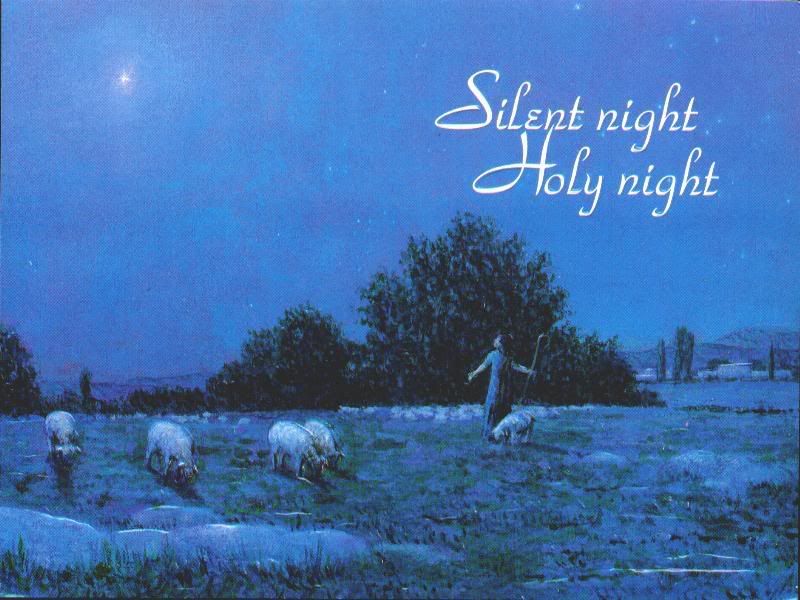Silent Night, Holy Night
Luke 2:8-9 And there were
shepherds living out in the fields nearby, keeping watch over their flocks at
night. 9 An
angel of the Lord
appeared to them, and the glory of the Lord shone around them, and they were
terrified.
On a
cold Christmas Eve in the year 1818, a young priest named Joseph Mohr
quickly walked from his home in the small town in Oberndorf, Austria to the
neighboring village of Amsdorf. He was carrying a piece of paper – a poem he
had written two years earlier.
He made his way to the schoolhouse,
walked up the stairs and knocked on the door of the second floor apartment. He
was greeted by his friend, Franz Gruber, the schoolmaster in Amsdorf and also
the church organist.
Father Mohr asked his friend to
help him put his poem to music. He wanted a new Christmas hymn for the mass
that evening. There was a catch, though. He wanted it played on guitar, not the
organ.
Over the years, many have
speculated why. Some say the organ was broken. Others say it was because of
Father Mohr’s love for the guitar. Whatever the reason, Gruber quickly wrote a
melody and guitar chords for the new Christmas carol.
That night at the Midnight
Mass, Father Mohr and Franz Gruber, quietly backed by the choir and accompanied
by a single guitar, sang the new hymn for the first time. It was called “Stille Nacht.” You and I know it as “Silent Night.”
“Silent Night” has
since been translated into over 140 languages and sung in every corner of the
world. This powerful little carol has so worked its way into people’s hearts
all over the world that it isn’t really Christmas unless you sing it at least
once, preferably on Christmas Eve.
Its popularity
contrasts sharply with its humble beginnings. “Silent Night” scholar,
Bill Eagan, once wrote: “Perhaps this is part of the miracle of Silent Night. The words flowed from the imagination of a
modest curate. The music was composed by a musician who was not known outside
his village. There was no celebrity to sing at its world premiere. Yet its
powerful message of heavenly peace has crossed all borders and language
barriers, conquering the hearts of people everywhere.”
It is not a joyous,
fast-paced carol like Handel’s “Joy to the World.” Nor theologically-rich
like Charles Wesley’s
“Hark,
the Herald Angels Sing.” Nor does it have a complex tune like “Angels
We Have Heard on High.”
Rather, “Silent Night”
is quiet and reflective, calling us to meditate on the scene. It is the
ambience conveyed by both the gentle words and melody that create from this
carol an oasis of peace.
The
quiet words, the soft melody and the lonely guitar reflect the reality of the
first Christmas. It was truly a silent night. In the
streets of the tiny village of Bethlehem, you might have been able to hear Mary’s
muffled moans as she gave birth to Jesus. You might have heard the delicate
cries of the newborn baby emerging from the manger. Few, however, would have
noticed.
Jesus’ birth was not reported on
CNN. There were no TV cameras or paparazzi at the stable. Social media was not
alerted. Jesus’ birth didn’t go viral until years later. It was a night like any
other.
On that night the almighty God was
born as a helpless baby and nobody noticed except a handful of shepherds who
were sleeping in the fields outside of Bethlehem.
But in reality, that silent night
was unlike any night. For during that holy night came our salvation. The baby
so tender and mild was born to die a painful death. He came to take your place
and suffer your punishment for all the hurtful things you think, say and do. He
came to win for you a home in heaven. Through that baby, God won and offers
eternal life to all people from every nation, tribe and language.
Deep theology
radiates from the simple words and pure pictures of this Christmas hymn. The
incarnation of Christ was not the actual blood-redemption, but it was the dawn
of redeeming grace. With the arrival of God’s Son on earth, the long centuries
of waiting were over and God’s plans were in motion. Grace fulfilled to us was
given from the golden heights of heaven.
The Christ Child was born in darkness that we might be reborn as children
of the light. He died in the darkness that we might live in the light of His
life. He rose at dawn to usher in the new day of His resurrection. He was born
on a silent, holy night in Bethlehem so that we might enjoy an eternity of
sunshine-filled days in the New Jerusalem.
Perhaps most of all, “Silent
Night” is beloved because it reminds us in its simple, but exceedingly clear
way, the truth behind it all – the truth that changes everything: “Christ, the
Savior is born!” Amen.

Comments
Post a Comment